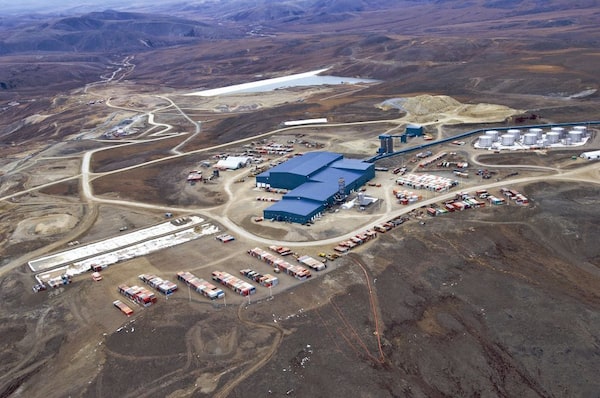
In early March, Kinross said that it was suspending its operations in Russia. And on Tuesday, the company said it plans to sell all of its Russian assets.Handout
Kinross Gold Corp. has been rallying over the past five weeks – a curious turn given that the Canadian gold producer has sidelined its operations in Russia and analysts have slashed their profit expectations.
The reason for the bullish shift: A stock that is untethered from Russia may be a more valuable stock.
The shares (K-T, KGC-N), have rallied almost 20 per cent from their lows on Feb. 28, soon after Russia invaded Ukraine, triggering sanctions and corporate departures. The share price is now higher than it was before the war began.
The gains last month outpaced bullion and the NYSE Arca Gold Bugs Index, which tracks the performance of 14 major gold producers, suggesting that investors are applauding the move away from Russia, even if the departure comes at a substantial cost.
In early March, Kinross said that it was suspending its operations there. And on Tuesday, the company said it plans to sell all of its Russian assets.
Gold producers have long embraced the risks associated with building and operating mines in emerging markets, where businesses can be vulnerable to sudden shifts in policies and regulations – and, in the case of Russia, war and sanctions.
Among the top 25 gold producing countries, according to data from the World Gold Council, just three are developed economies: Australia, the United States and Canada.
The other 22 countries are emerging economies, accounting for more than 76 per cent of the total volume of gold produced by the group.
Some executives – including Mark Bristow, now chief executive of Barrick Gold Corp. – have championed emerging markets as the source of essential growth, given that the gold industry for years has been mining far more gold than it is discovering.
But mining executives also recognize that geopolitical risks are real.
After Ukraine invasion, Kinross Gold plans for a future without Russia
Kinross Gold in talks to sell Russian operations amid continuing Ukrainian invasion
According to a 2021 survey of global mining and metals executives by Ernst & Young, geopolitics has moved into the No. 4 spot among the top 10 risks facing the industry this year. The risk didn’t crack the top 10 in the 2019 survey.
What’s more, mining executives now see environmental and social issues as the No. 1 risk, reflecting the rising importance of ESG principles – which include governance – for attracting capital.
Russia is now widely regarded as a no-go zone for investments tied to these principles.
This may explain why Kinross shares have been performing better since the company moved toward the exits, even if it ultimately sells its Russian assets at a significant discount to their intrinsic value and loses a big chunk of production.
Farooq Hamed, an analyst at Raymond James, said that Kinross’s Russian assets represented about 13 per cent of the company’s 2022 estimated production and about 12 per cent of operating cash flow.
Tanya Jakusconek, an analyst at Bank of Nova Scotia, jettisoned the assets from her financial calculations last month. As a result, she cut her estimated 2022 profit for Kinross to 48 US cents a share from 56 US cents previously. That’s a 14-per-cent reduction.
While that might look like an odd start for a rally, there is some good news here.
For one, Ms. Jakusconek argued in early March that the stock, at its lows, no longer reflected any value in Russian assets. That leaves an upside for investors if Kinross gets a decent price for them – or any price, for that matter.
“We do not include the Russian assets in our net asset value or target price, so any sale proceeds would be accretive,” she said in a note this week.
What’s more, the shares may be attracting investors that had been wary of the company’s exposure to Russia, which has weighed on the stock’s valuation over several years.
“The reality is that geopolitical risk was probably one of the main issues why the stock traded at a discount to the peer group,” Michael Curran, an analyst at Beacon Securities, said in an interview.
While stocks such as Barrick, Agnico Eagle Mines Ltd. and Newmont Corp. trade at a premium to net asset value and cash flows, Kinross trades at a significant discount.
The bullish case for the stock now rests on this discount narrowing as its geopolitical exposure becomes limited to more palatable countries in South America, North America and Africa.
“It stands up as more comparable to the other senior producers – so maybe in three to 12 months we’ll see the valuation gap narrow, where Kinross trades at higher levels,” Mr. Curran said.
Be smart with your money. Get the latest investing insights delivered right to your inbox three times a week, with the Globe Investor newsletter. Sign up today.
 David Berman
David Berman